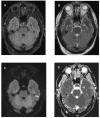Bickerstaff's brainstem encephalitis associated with anti-GM1 and anti-GD1a antibodies
- PMID: 32948528
- PMCID: PMC7511636
- DOI: 10.1136/bcr-2020-236545
Bickerstaff's brainstem encephalitis associated with anti-GM1 and anti-GD1a antibodies
Abstract
Bickerstaff's brainstem encephalitis (BBE) is a Guillain-Barré syndrome (GBS) spectrum disorder associated with predominantly central nervous system predilection. Patients exhibit a variable constellation of depressed consciousness, bilateral external ophthalmoplegia, ataxia and long tract signs. Although the pathophysiology is not fully understood, it has been associated with anti-GQ1b antibodies in two-thirds of patients. We present a patient with clinical features consistent with BBE and positive anti-GM1 and anti-GD1a antibodies. A diagnostic approach to the acutely unwell patient with brainstem encephalitis is explored in this clinical context with a literature review of the aforementioned ganglioside antibody significance. Intravenous immunoglobulin therapy is highlighted in BBE using up-to-date evidence-based extrapolation from GBS.
Keywords: brain stem / cerebellum; cranial nerves; neuro ITU; neurology.
© BMJ Publishing Group Limited 2020. No commercial re-use. See rights and permissions. Published by BMJ.
Conflict of interest statement
Competing interests: None declared.
Figures


References
Publication types
MeSH terms
Substances
LinkOut - more resources
Full Text Sources
Medical
